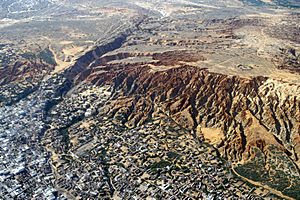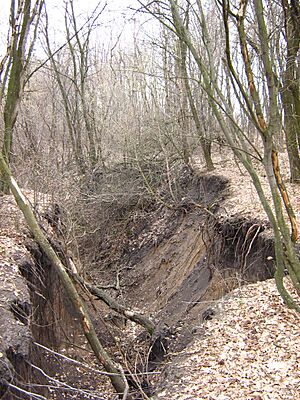Gully facts for kids

A gully is a type of landform made by flowing water. It's like a large ditch or a small valley. Gullies form when water cuts deeply into soft ground, usually on a hillside. They can be several meters deep and wide. When a gully is forming, a lot of water flows through it. This powerful flow can carve out the ground very quickly.
Contents
What Does "Gully" Mean?
The word "gully" first appeared in 1657. It comes from the French word goulet, which means "throat." It might also be linked to a type of knife called a gully-knife that was used a long time ago.
How Gullies Form and What Happens
Gully erosion is the process that creates gullies. Hillsides are more likely to get gullies when their plants are removed. This can happen because of deforestation (cutting down forests) or too much grazing by animals. When plants are gone, the soil is loose and easily washed away by water.
This usually happens during short, strong rainstorms, like thunderstorms. The flowing water picks up the loose soil. A gully can grow longer by eroding its own beginning, moving upstream. This erosion can happen from water flowing on the surface or even water flowing underground.
Gullies can harm farmland by cutting into the soil. They also create sediment (tiny bits of soil and rock) that can fill up rivers and other water bodies downstream. Because of these problems, scientists study gullies to learn how to prevent them and how to fix land that has been damaged by them. A lot of soil can be lost when gullies form and when that soil ends up in rivers.
Human-Made Gullies
People can also create or make gullies bigger. This often happens during a type of mining called hydraulic mining. In this method, strong jets of water are used to wash away soft ground. Miners do this to find valuable minerals like gold or tin ore.
You can still see the remains of this mining method in old goldfields. For example, the badlands at Las Medulas in Spain were made by the Romans. They used aqueducts to bring water from rivers. This water was then used to wash away the gold-rich soil, creating huge gullies. The washed-away soil was then carefully cleaned with smaller streams of water to find gold nuggets and dust.
Gullies on Mars
Gullies are also found on Mars, especially in its middle and upper parts. These Martian gullies are some of the newest features seen on the planet. They probably formed in the last few hundred thousand years.
These gullies are important because they suggest that liquid water might have been on Mars recently. They could have formed when snow on the surface or ice underground melted slightly during warmer times on Mars. It's also possible that some Martian gullies formed from water flowing out of deep underground aquifers.
Gallery
-
A gully in Saratov Oblast, Russia.
-
Voçoroca (Portuguese for gully) in Avaré, Brasil
Images for kids
-
A gully formed from volcanic soil in West Java, Indonesia.
See also
 In Spanish: Cárcava para niños
In Spanish: Cárcava para niños






